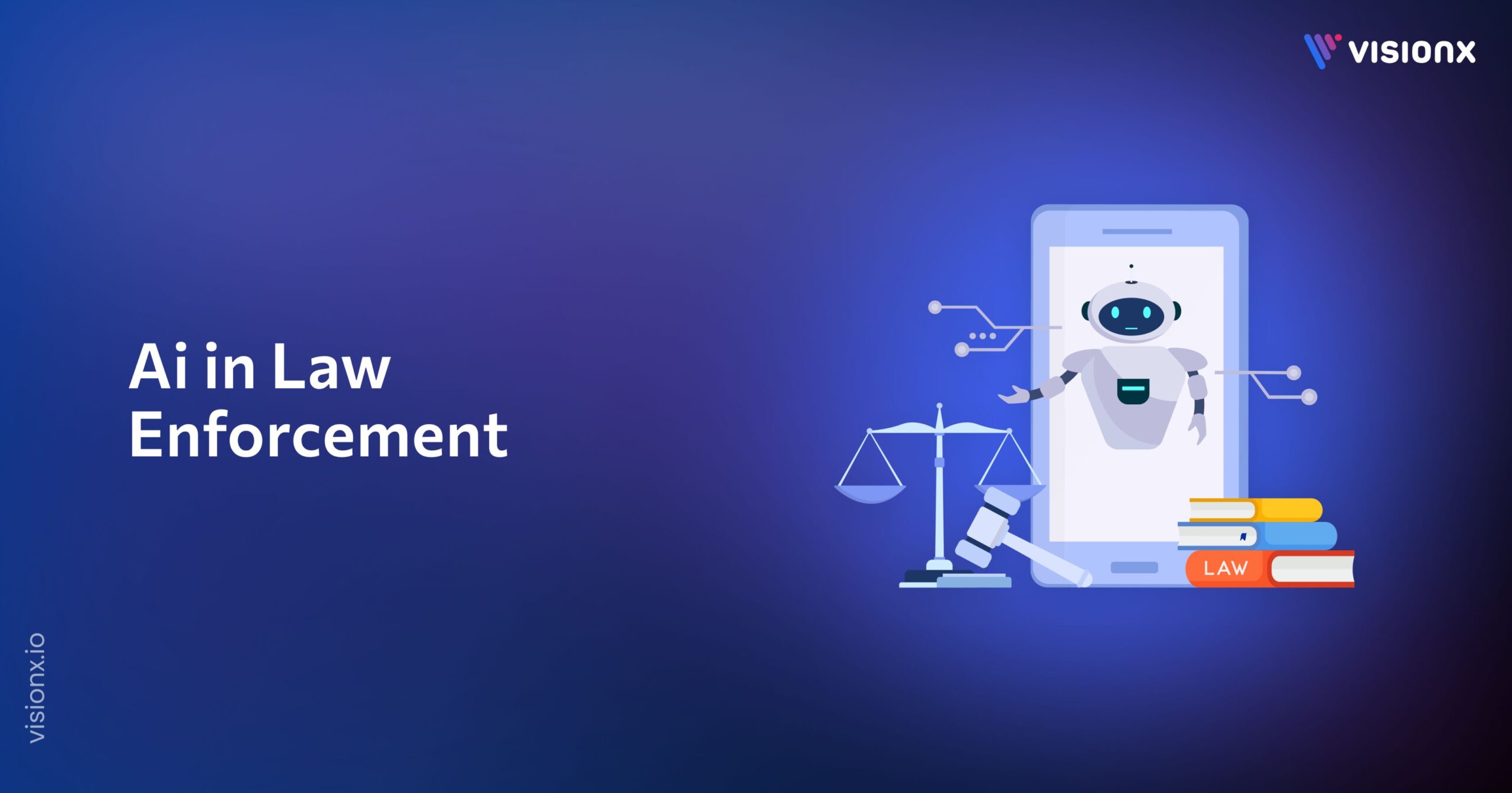Sometimes a single tip can stop a crime before it happens. This is the reason why police departments currently use AI in law enforcement to turn scattered information into clear alerts. AI systems identify hidden patterns from various sources like cameras, reports, social media, and sensors.
Policing agencies use AI to manage data streams that are often overwhelming and try to get some meaning from that data. A survey found that 85 % of police officers said AI in law enforcement is very important for future investigations. AI-powered tools help officers spot risks, connect clues, and make faster, smarter decisions in real time.
This blog will explain how AI is used in law enforcement, the different types of AI tools, and how AI will impact policing in the future.
Key Takeaways
- AI in law enforcement helps officers analyze large volumes of data, enhancing decision-making and public safety.
- Applications like crime forecasting, suspect identification, forensic analysis, and operational support improve efficiency and effectiveness.
- AI accelerates investigations, optimizes resource allocation, and strengthens situational awareness across departments.
- Awareness of potential bias, privacy concerns, costs, and system compatibility is essential for responsible AI deployment.
What is AI in Law Enforcement?
AI in law enforcement is a type of technology that helps police officers make sense of large amounts of information. It uses AI and machine learning to study data from reports, cameras, sensors, and social media. This helps officers notice patterns, identify faces, and find important clues that are hard to see with the human eye.
In simple words, it supports decision-making, keeps communities safer, and gives law enforcement agencies more effective means to carry out their work.
Role of AI in Law Enforcement
The role of AI in law enforcement is to work alongside officers to process information more rapidly, improve response times, and boost public safety. It has the capability to identify incidents that are out of the ordinary, point out new crime trends, and give support to the officers in making their decision on which cases to deal with first. A Deloitte study found that integrating AI-driven tools could reduce urban crime rates by 30–40% in some cities.
Officers use AI to:
- Predict potential crime locations
- Study historical crime data
- Shorten emergency response times
Moreover, it aids in AI-driven law enforcement report writing, surveillance of public spaces, and case monitoring. AI law enforcement gives officers the opportunity to focus on community safety and rapid incident response, as AI provides them with clear and useful viewpoints.
Types of AI Used in Law Enforcement
Police departments utilize several types of AI to assist them with their activities. Each AI type offers different support to the officers and can bring advancement to criminal investigations, documentation, and even the overall safety of the citizens. The following are the various types of AI used in law enforcement.
1. Machine Learning (ML):
It takes into account extensive data such as arrest records, crime scenes, and past information, and identifies patterns and forecasts.
- Predictive policing/crime forecasting involves determining the areas that can be hotspots and forecasting crime when and where it is likely to occur, to design efficient patrols.
- Assessment of risk is used to determine an individual’s likelihood of re-offending or failure to appear in court, with the aim of making decisions in the justice system.
2. Computer Vision:
This allows computers to comprehend visual information from pictures and videos.
- Facial recognition can match faces from cameras or databases to find suspects or missing people.
- Video analytics and surveillance cameras track camera feeds in order to identify weapons, suspicious behavior, or crimes in progress in real-time.
- Automated license plate recognition (ALPR) is a technology that automatically reads and compares vehicle license plates to stolen car or wanted individual databases.
- The biometrics and forensics also assist in matching the fingerprints, DNA testing, and surveying other pieces of evidence.
3. Natural Language Processing (NLP):
Natural Language Processing (NLP) helps computers understand what we say and write.
- Automated report writing can produce drafts of police reports using officer notes or body camera footage.
- Data analysis review reports, emails, social media posts, and case files to find important links and speed up investigations.
- Emergency response support analyzes 911 calls, detects keywords for urgent situations, and provides language support when needed.
4. Autonomous Robotics:
Robots and drones handle tasks, especially in high-risk situations.
- Drones as first responders come in before the officers to give them a live view, scan threats, and find hideouts.
- Collision and accident investigation refers to mapping and reconstruction of traffic accidents or arson.
5. Process Automation:
It takes care of the mundane, recurring activities, which saves you valuable time and makes everything run smoothly.
- Computer-Aided Dispatch (CAD) helps dispatchers focus on what’s important and get help to people faster.
- Digital Forensics pulls out and sorts data from devices for investigations.
- Officer monitoring reviews performance, body camera footage, and complaints to flag risks or recognize strong work.
You can learn more about various AI categories further in our detailed guide on branches of AI.
How AI Is Used in Law Enforcement
The following are the key applications of Artificial Intelligence in law enforcement:
Crime Prevention and Crime Forecasting
AI scrutinizes the past crime data and the trends to forecast the time and place of future crimes. As a result, police can optimize their patrolling schedules, keep crime from happening, and assist in predictive policing efforts. Also, by identifying trends and finding new threats, AI in law enforcement guides the cops where to put the resources and also helps with the overall security of the public.
Investigation and Suspect Identification
AI helps to examine reports, surveillance videos, and social networks to make connections between criminals, reveal tips, and accelerate the process of case resolution. Various tools, such as facial recognition technology, expedite the identification of people, while machine learning helps to associate related events across different locations. The use of AI in law enforcement grants the ability to solve cases more swiftly and with higher precision.
Forensic Science Enhancement
The usage of AI in Forensic Science is an advantage to the entire process of examining fingerprints, DNA, and other evidence. AI can automate tough analysis and find hidden patterns that people might miss during investigations. By using AI, forensic teams can give quicker, more reliable results in areas like DNA analysis and identifying people. This helps the criminal justice system make better choices.
Operational and Administrative Support
AI for law enforcement facilitates the report-writing process, organizing case files, and prioritizing calls, which in turn reduces the administrative load placed on the officers. This not only allows officers to be more present in the field but also improves overall workflow and reduces response time. The incorporation of AI plays an important role in managing the workflows of police departments by ensuring that the necessary resources support operations at all times.
Community Interaction and Transparency
AI assists police departments in public opinion monitoring, social media analysis, and crime trend mapping to keep communities updated. Such techniques provide organizations with the ability to be open and transparent, ensuring public trust and guiding AI-based officer training. AI is also encouraging law enforcement and the public to adopt more constructive communication, promoting both security and community involvement.
Pros and Cons of AI in Law Enforcement
AI is helping officers work smarter and faster, however like any technology, it has both advantages and challenges.
Pros
The following are the pros of AI in law enforcement.
- AI in law enforcement can predict the future of crimes, thus allowing police departments to block such incidents based on the study of past crimes.
- AI law enforcement tools scrutinize writing, video materials, and social networking posts, making it easier for the police to solve cases quickly.
- The AI and law enforcement sector assists in distributing people and machines according to the demands at the most efficient places, thus reducing the time taken to respond.
- AI-based forensic methods help in the analysis of fingerprints, DNA, and other biological markers, giving rise to the possibility of getting more precise outcomes.
- Moreover, AI facilitates the communication of reports and public announcements, as well as training in AI for law enforcement, thus contributing to the development of more solid ties with the community.
Cons
The following are the cons of AI in law enforcement.
- Unfair data or incomplete data characteristics may lead some AI systems to produce biased results.
- Broader monitoring, facial recognition, and social media analysis could trigger people’s concerns about privacy.
- Deployment of AI technologies necessitates costly hardware, software, and personnel training.
- Overreliance on AI law enforcement tools may mitigate the critical aspect of human judgment in decision-making.
- Not all AI solutions for law enforcement are compatible with the existing systems, which leads to delays and errors.
How Will AI Affect Policing in the Future?
AI will affect policing by increasing the speed and efficiency of the work done through automation and data analysis. AI in law enforcement will allow officers to review digital evidence, automatically synthesize written reports, and assist with situational awareness in the moment. It will also enable both predictive policing and monitoring of public spaces.
In the future, AI and law enforcement will enable smarter patrol planning, faster case investigations, and stronger community engagement. Officers will access tools that facilitate data-based and informed decision-making. This will allow the police department to respond faster, prevent crime before it happens, and succeed in public safety outcomes.
How VisionX Transforms Policing with AI Technology
VisionX provides policing agencies with AI solutions that improve operational efficiency, accuracy, and safety. Our customized solutions rely on computer vision, predictive analytics, and natural language processing to identify patterns, detect threats, and improve investigations.
VisionX integrates AI into current surveillance and case management systems, helping agencies to analyze data, forecast crime trends, and improve situational awareness. Our solutions, designed with privacy and transparency in mind, allow police to be smarter and more proactive.
Partner with VisionX to modernize law enforcement with intelligent AI technology.
FAQs
What are the cons of AI in law enforcement?
The main cons are potential biases, privacy issues, very high expenditures, system incompatibilities, and technology that is overly relied upon.
What are the top 3 trends in the law enforcement industry?
Modern law enforcement is being profoundly transformed by predictive policing, surveillance with AI, and the delegating of clerical work to machines.
How does AI improve investigations?
AI sorts the data, finds the patterns, and connects the dots of the evidence, which leads detectives to a quicker and more precise resolution of the case.
Is AI being used in criminal justice?
Absolutely. AI is involved in the areas of risk assessments, case analysis, policing based on predictions, and report writing within the criminal justice system.
Can AI monitor social media for law enforcement purposes?
Yes. AI scans social media to detect threats, criminal activity, and public safety concerns, supporting proactive policing.


